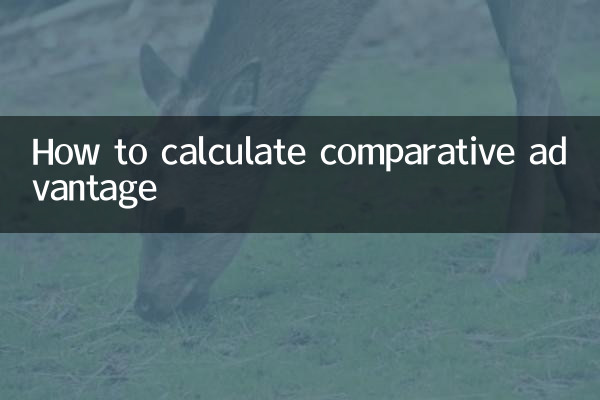How to calculate comparative advantage
In today's increasingly globalized world, understanding the calculation method of comparative advantage is crucial for individuals, companies and even countries to formulate economic strategies. This article will combine the hot topics and hot content on the Internet in the past 10 days, analyze the calculation method of comparative advantage in detail, and help readers master this core concept of economics through structured data.
1. What is comparative advantage?

Comparative advantage was proposed by economist David Ricardo and refers to the lower opportunity cost of an economy in producing a certain good or service relative to other economies. Even if a country does not have an absolute advantage in the production of all goods, it can still gain benefits from trade by focusing on the production of goods in which it has a comparative advantage.
2. Calculation steps of comparative advantage
1.Determine production possibilities: First, it is necessary to clarify the goods that the two economies can produce and their output.
2.Calculate opportunity cost: Opportunity cost refers to the amount of one commodity that is given up to produce another commodity. Opportunity cost can be calculated by comparing the production efficiency of two goods.
3.Compare opportunity costs: Comparing the opportunity costs of two economies when producing the same commodity, the one with lower opportunity costs has a comparative advantage.
3. Calculation examples
Suppose there are two countries: Country A and Country B. They can both produce wheat and cloth, but their production efficiency is different. Here are their production figures:
| nation | Wheat (tons) | Cloth (meters) |
|---|---|---|
| Country A | 100 | 200 |
| Country B | 50 | 100 |
1.Calculate opportunity cost:
For country A:
For country B:
2.Compare opportunity costs:
Although country A has an absolute advantage in the production of both goods (higher output), the opportunity costs of both countries are the same, so in this example there is no difference in comparative advantage between the two countries. But in practice, opportunity costs often vary.
4. Comparative advantages in practical applications
Among recent hot topics, the reorganization of global supply chains and the advancement of regional economic cooperation (such as RCEP) have once again highlighted the importance of comparative advantages. The following are some practical application scenarios:
| scene | manifestation of comparative advantage |
|---|---|
| China manufacturing industry | Labor costs are low and it has a comparative advantage in producing labor-intensive products |
| U.S. high-tech industry | Strong technical research and development capabilities and comparative advantages in the production of high-tech products |
| Southeast Asian Agriculture | The climate conditions are superior and it has a comparative advantage in the production of tropical agricultural products. |
5. Dynamic changes in comparative advantage
It is worth noting that comparative advantage is not static. Technological progress, changes in resource endowments, policy adjustments and other factors may change the comparative advantage of an economy. For example, China's rapid rise in the field of new energy vehicles in recent years has reshaped its comparative advantages in this field precisely through technological innovation and policy support.
6. Summary
The core of calculating comparative advantage lies in the comparison of opportunity costs. By identifying production possibilities, calculating opportunity costs, and making comparisons, an economy's areas of comparative advantage can be clearly identified. In today's rapidly changing global economic landscape, mastering this method is of great significance for formulating scientific economic strategies.
Whether it is personal career choices, corporate production decisions, or national trade policies, the theory of comparative advantage can provide valuable guidance. I hope that through the analysis of this article, readers can have a deeper understanding and application of this economic principle.

check the details

check the details